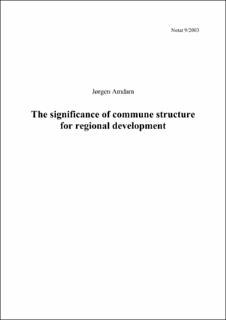| dc.description.abstract | The geographical structure of an area will have a great influence on which tasks it is expedient for communes to co-operate on and similarly what consequences that may result from an amalgamation of communes. The focus here is local and regional development and the role of the communes as local planners in co-operation with other actors locally, regionally and nationally. What have the consequences been for development work in amalgamated communes? Can communes in regions with a different geographical structure learn anything from amalgamated “urban regions”? How does the regional co-operation function, is it an alternative to the merging of communes in the context of local development? These are some of the questions we asked ourselves in our work of looking at the connection between commune structure and local development.
In order to be in a position to say something about the consequences of changes in commune structure for local development in an area, it is necessary, in addition to taking material and economic considerations, to also study the interests of the different actors, the relations between them, the social capital in the area and not least how the ability to mobilise for development is influenced. There are also great differences between different regions in Norway when it comes to the challenges facing them and the consequences, for example between “close-lying urban regions” and “sparsely populated rural regions”. In this study we can demonstrate positive consequences for regional development in regions like Sarpsborg and Fredrikstad and we believe that under certain circumstances it will be possible to achieve similar positive consequences in other such “urban regions”. We are in far greater doubt about whether it is possible to achieve similar effects in regions with many and small centres and a far lower degree of integration in housing, working and service conditions, especially if there is already a lack of trust and co-operation. | en_US |
